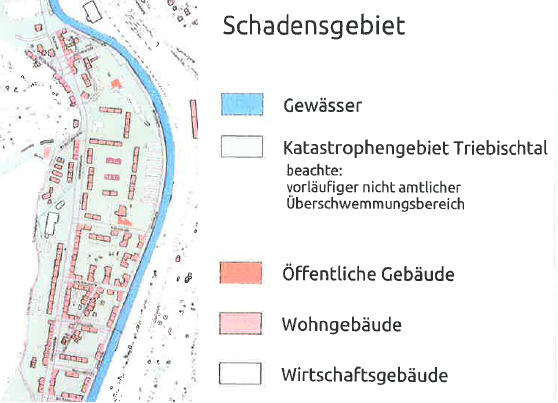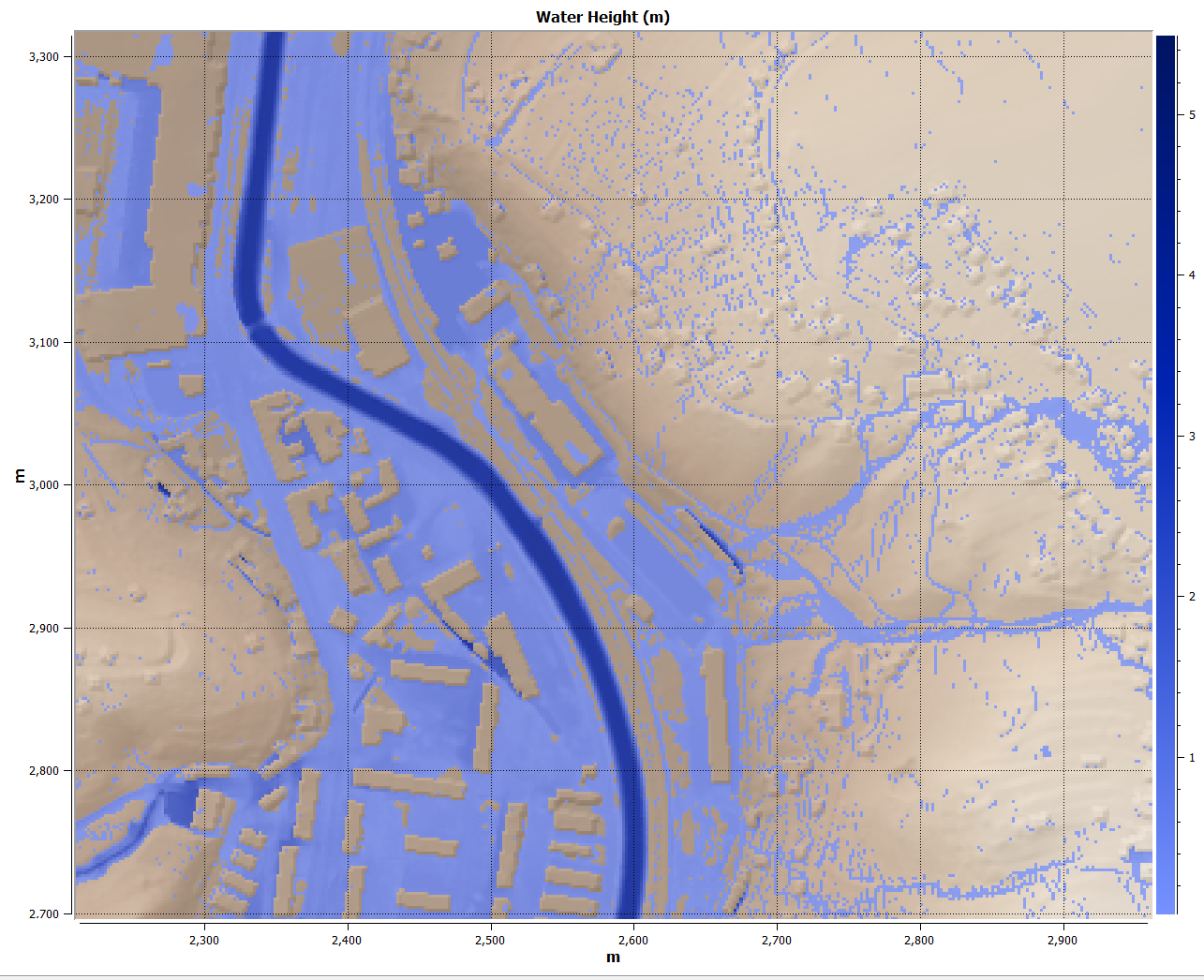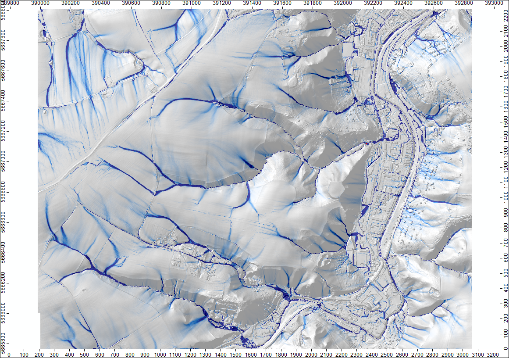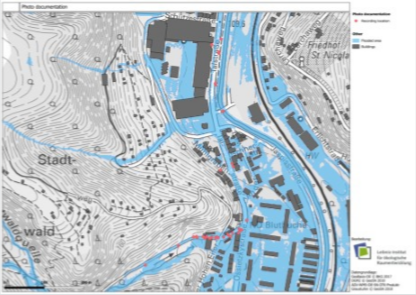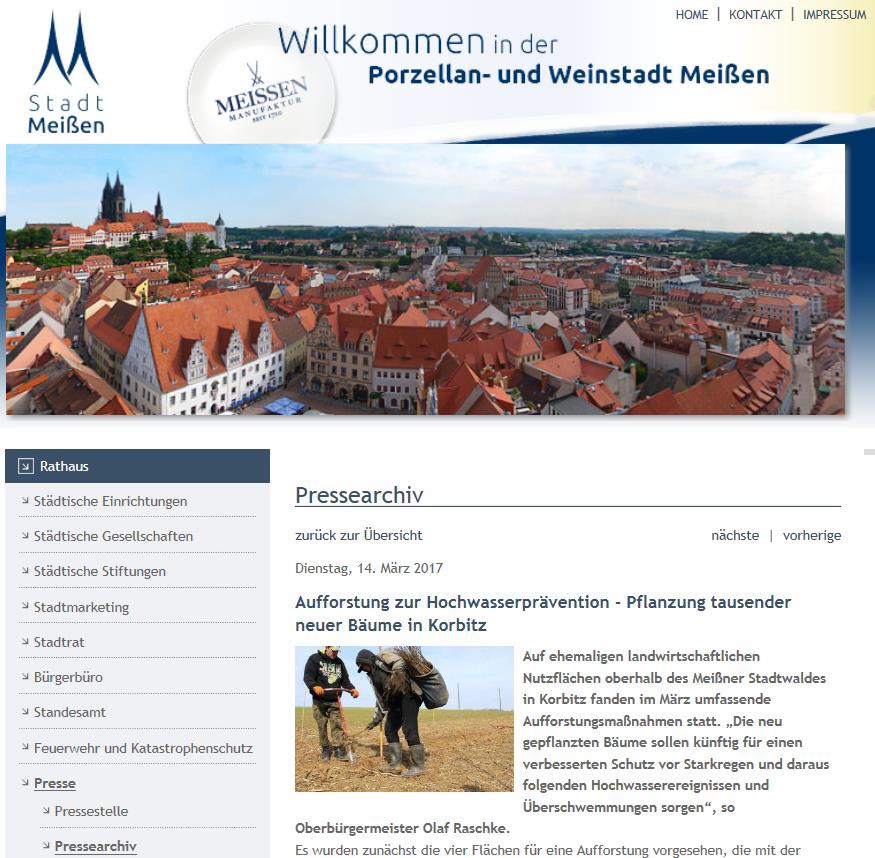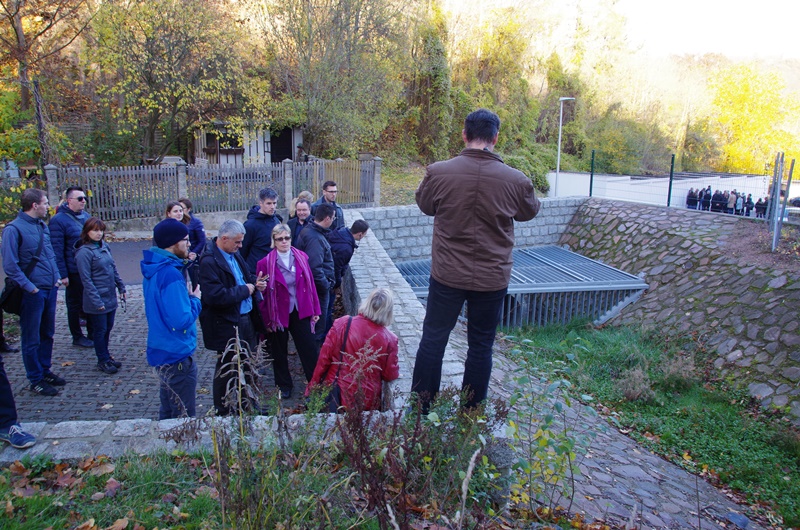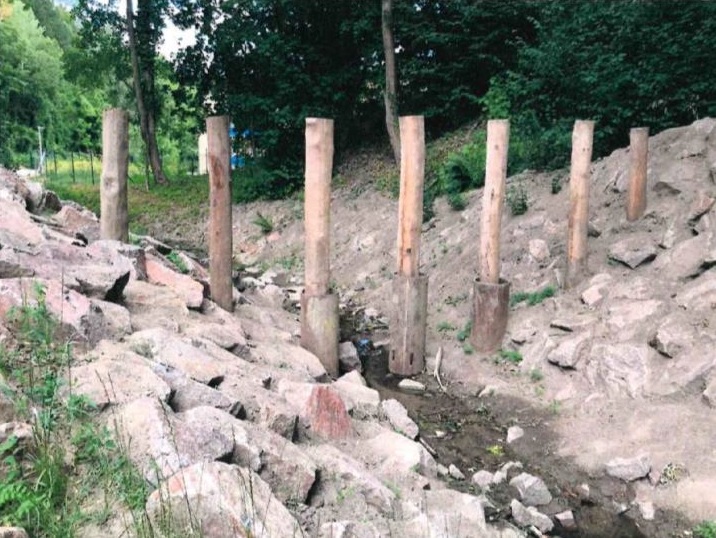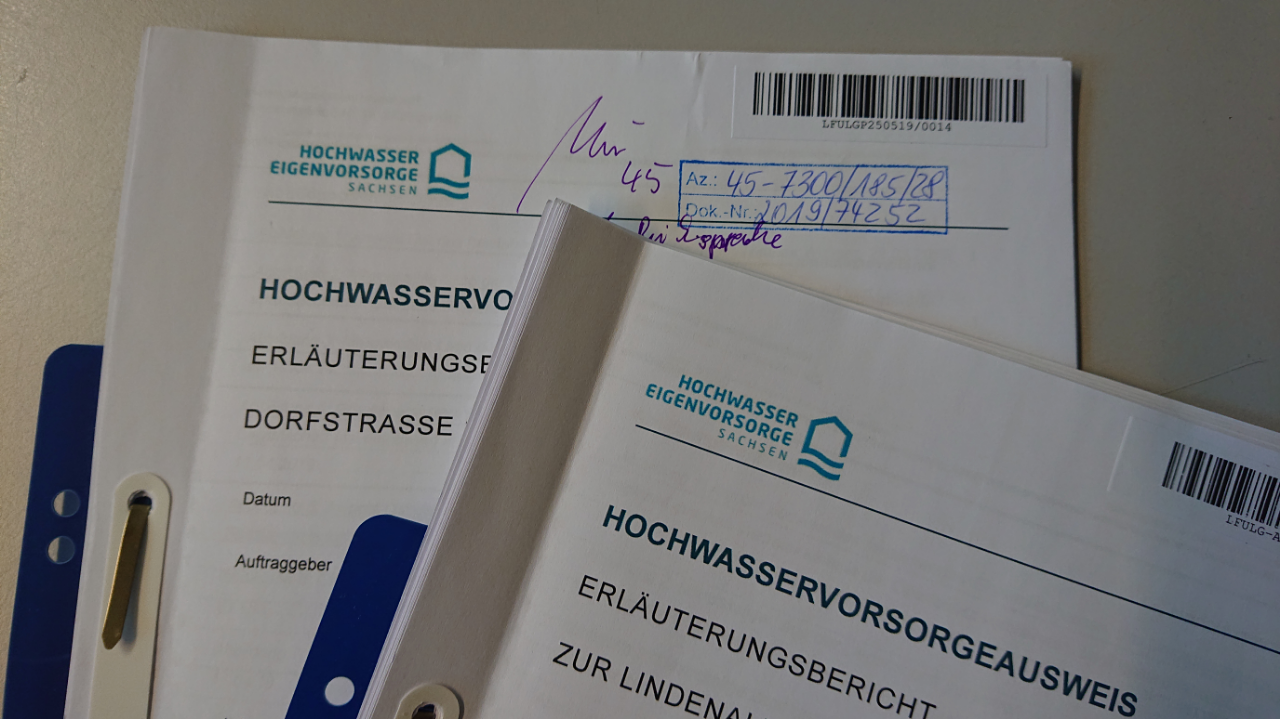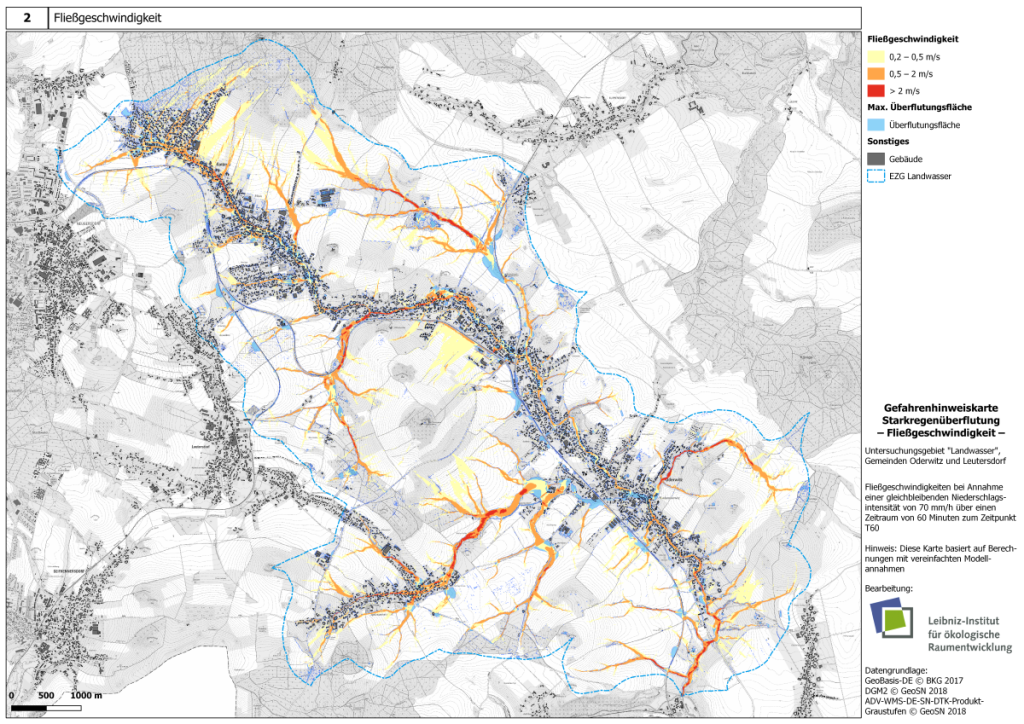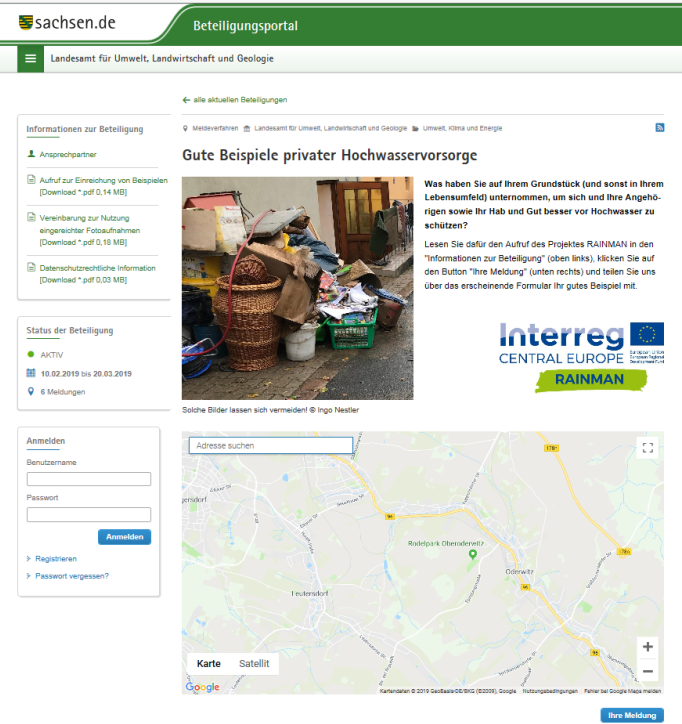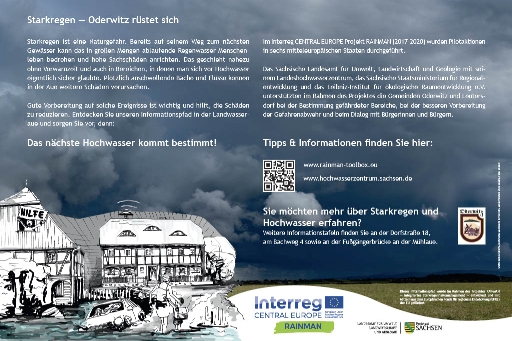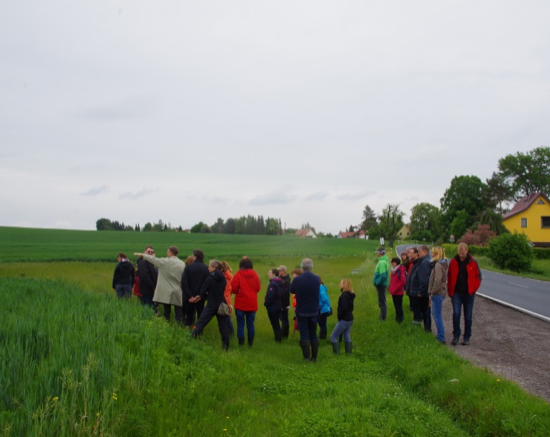Our story from SAXONY, GERMANY

Floods have caused enormous damage in Saxony in recent years and great efforts have been made to reduce the flood risk in flood plains. The realisation that more needs to be done to reduce the risk outside these areas prompted three Saxon institutions to become involved in RAINMAN: the Saxon State Office for Environment, Agriculture and Geology (LfULG), the Saxon State Ministry for Regional Development (SMR) and the Leibniz Institute for Ecological Urban and Regional Development (IOER).
Administrations at different levels (local & regional) supported the Saxon RAINMAN project partners in the implementation of the pilot action with their practical knowledge and especially with their accumulated experience in dealing with floods caused by heavy rainfall. Together with the municipalities of Oderwitz and Leutersdorf as well as the cities of Meissen and Görlitz (professional fire brigades), the project partners tested and validated innovative methods for risk assessment and mapping and organised risk communication and reduction measures. The results were exchanged within the Saxon RAINMAN sphere of activity and across national borders. In Saxony, the pilot action has influenced administrative work at state, regional and local level.
OVERVIEW
Activities:
- assess and map risks
- communicate risks
- identify risk reduction measures
Land use:
- urban, semi-urban, rural , agricultural
Land form / terrain:
- flatland, hilly, mountainous
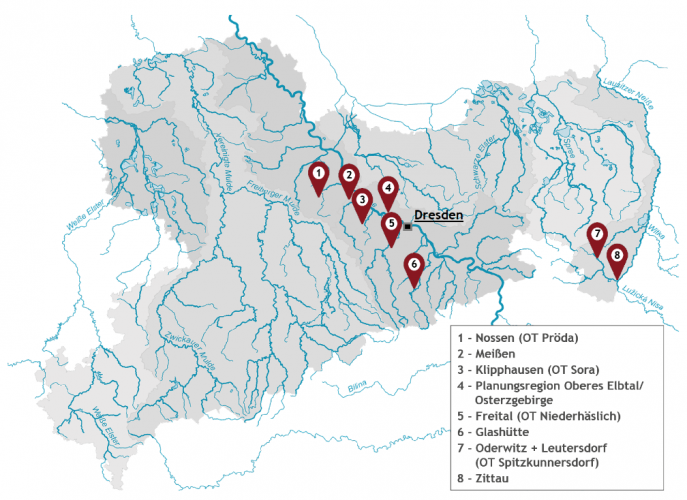
CITY OF MEISSEN
The historic city of Meissen is situated at the river Elbe at the confluence of the river Triebisch about 25 km northwest of the state capital Dresden. The city covers an area of 31 km² and has 28,000 inhabitants. Both in the city centre and in the surrounding districts, the landscape is characterised by many historical buildings. Apart from the river floodplains, the city is surrounded by higher situated, large and gently rolling agricultural areas on loess soil, in which deep and steep valleys have been carved by prehistoric erosion processes. The valley slopes are either covered with forest or belong to the settlement area. The other settled areas are located on the valley bottom of the river Triebisch, on valley terraces of the river Elbe and on the higher lying areas.
Meissen has a lot of experience with floods – especially with the flooding of the Elbe river. Flood protection concepts and flood risk management plans for the larger water bodies are available. In May 2014, after a heavy rainfall event of 40-60 l/m² of precipitation per hour, insignificant tributaries turned into torrents. The enormous power of the water led to deep erosion furrows in the fields, penetrated the settlement areas on the plateaus and, among other effects, transformed the idyllic valley of the brook Kirchsteigbach – an urban recreation area – partly into a wild canyon. Large quantities of water, wood, rubble and mud destroyed the houses and infrastructure below in the valley of the river Triebisch. Entire streets were torn up and washed away. The torrential rain caused damage amounting to EUR 6 million.
Even before the flood event of 2014, the city of Meissen already had a landscape plan which indicated the danger of erosion in the sub-catchment areas to the left and right of the river valley of the Triebisch and recommended measures to improve water retention. Immediately after the flood event, the City of Meissen commissioned a hydrological study and a damage analysis at its own expense. The recommendations formulated in this study for various measures for restoration and for flood risk reduction formed the conceptual basis for all further action.
Recommended measures were, for example, structural measures, especially the construction of several small retention basins, reforestation and grassland establishment on the more inclined arable land for better water retention and reduced erosion in the catchment area above the v-valley, as well as the replacement of destroyed bank areas, bridges and culverts in the valley ground. Furthermore protective structures were recommended to reduce risk and improve the watercourse structure where the run-off water passes into the settlement area. Each measure on its own would not have a major impact; but in combination the measures have a significant risk-reducing effect. The city has used various funding options to implement the measures. The implementation of some measures is still pending. The city administration has accompanied the construction measures with much public relations work and activities to increase knowledge about the complex issue of flooding.
The participation in the RAINMAN project was also part of the non-structural measures of the city administration and served to acquire knowledge and furthermore to raise awareness of the citizens. This is because in other parts of the municipal territory the heavy rain risk is still high and further efforts are needed at all levels to reduce it elsewhere.
BROWSE OUR STORIES
- All
- Assessment and mapping
- Risk reduction measures
- Risk communication
MUNICIPALITIES ODERWITZ AND LEUTERSDORF, DISTRICT SPITZKUNNERSDORF
The neighbouring communities Oderwitz and Leutersdorf with its district Spitzkunnersdorf are located in the eastern border triangle of Germany and share the international catchment area of the Neisse River with its neighbours Poland and the Czech Republic. They are situated in the immediate foothills of the Zittau Mountains (Zittauer Gebirge). The area of both municipalities amounts to 55 km². The hilly landscape (300-500 m above sea level) is characterized by agricultural land use (arable land and meadows as well as >5% forest). Oderwitz (5,500 inhabitants) and Spitzkunnersdorf (1,800 inhabitants) are both historically grown, elongated villages, whose buildings have developed in the past centuries mainly in the valley location along the waters. The villages are characterised by small historic half-timbered houses (Umgebindehäuser), which are protected as cultural monuments. The houses are mostly located near the watercourses in the valley bottom and on the slopes.
The Spitzkunnersdorfer Wasser is a small brook, which runs in a strongly developed stream bed with steep slopes through the densely built-up village. The municipality is responsible for the maintenance of the watercourse and for flood protection. On terrain of the municipality Oderwitz it flows into the small river Landwasser. Only the upper section of this stream is under municipal responsibility, further down the Landwasser is maintained by the The State Reservoir Administration of Saxony (Landestalsperrenverwaltung LTV).
Severe flooding has been a frequent occurrence in this area in the past, and it is part of the social memory of the long-established villagers. However, there is the (subjective) impression that heavy rainfall in the recent past has become more frequent and more intense in this area.
The flood processes of the recent past were complex and included “classical” river floods with high discharge peaks of the brook Spitzkunnersdorfer Wasser and the small river Landwasser as well as river-independent uncontrolled surface runoff mainly from the agricultural areas, which flowed down into the settlement area.
The flood events, which were in the focus of the RAINMAN project (Oderwitz: 2013, Spitzkunnersdorf: 2017), were characterised by convective thunderstorms in the early summer months with varying extent. According to their natural characteristics, the catchment areas reacted with very rapid runoff peaks, with practically no warning time. The uncontrolled runoff massively eroded soil from the fields, especially in areas where crops such as corn were still in their early stages of development. The eroded material deposited as mud on the roads and in the gardens and basements of the villages. These deposits were responsible for much of the damage observed. The combination of an unfavourable geographical situation, the high vulnerability of the historic buildings and the traumatic and existential experiences of the village population with the floods made coping and preventive measures urgently necessary.
The Spitzkunnersdorfer Wasser forms a flood runoff sub-catchment area of the total catchment of the small river Landwasser. Not only Oderwitz but also the municipalities Kottmar (upstream) and Mittelherwigsdorf (downstream) up to the confluence with the river Mandau belong to this catchment area. A flood risk management plan exists for the Mandau including Landwasser since 2004. The European Floods Directive is also being successively implemented at the smaller water bodies.
Along the watercourses for which they are responsible, both municipalities have initiated flood risk management plans with the support of the Lower Water Authority of the district of Görlitz since 2010 after the past flood events and have planned and implemented numerous recovery measures. With the end of the recovery phase, the focus of the municipalities shifted to precautionary measures and area-related measures. It was precisely this shift in emphasis that was accompanied and supported by RAINMAN in its pilot action. RAINMAN advised and trained the employees of both municipalities with the aim of implementing further risk reduction measures, which were aiming at improvement of water retention, improvement of behavioural and structural precautions of the potentially affected citizens, as well as adapted, water-sensitive land management and many other measures. In particular, measures for risk communication including the implementation of the Saxon Flash Flood Early Warning System and measures to improve emergency response were accompanied.
The implementation of preventive measures will remain an important task for local and regional authorities and other stakeholders in the future.
BROWSE OUR STORIES
- All
- Assessment and mapping
- Risk reduction measures
- Risk communication
FURTHER AREAS
In addition to the activities in the pilot action areas Meissen and Oderwitz/Leutersdorf, the project was in exchange with local and regional administrations, institutions, persons and projects throughout Saxony during its duration. This served to build up knowledge. Thus, exemplary solutions from entire Saxony could be collected for sharing the experience and knowledge gained with others and for integrating them here.
The Free State of Saxony is the south-easternmost state of Germany and borders on Poland and the Czech Republic. It has a size of about 18,000 km² and has about 4 million inhabitants, who live in larger cities (Leipzig, Dresden, and Chemnitz) but also in many small towns and villages. Saxony has various geographical sub-regions, e.g. low lying and fairly plain areas around Leipzig and in northern Lusatia (to 150 m a.sl.) hilly areas of a low elevation (to 300 m a.s.l.) from the west to the very east, and higher mid elevation mountainous areas in the Ore Mountains (to 1,200 m a.s.l.). The landscape is characterised by flowing waters of about 15,000 kilometres length. Most of the rivers have their source in the south and then mostly run northwards through hilly terrain and further to the lowlands.
The climate in Saxony is characterised by a naturally high variability of the climate. This is because the region lies at the interface of maritime (west) and continental air masses (east). Additionally, the Ore Mountains influence the air mass movement. In the past, Saxony had a positive water balance with a precipitation average of about 800 mm per year and a relatively even distribution throughout the year. However, regional climate analyses showed that extreme precipitation events have increased in frequency and intensity in Saxony over the last 50 years. The seasonality of precipitation extremes shifted from early summer to mid-summer. Additionally, there is a general trend towards more dry conditions in summer.
Saxony has a lot of experience with different types of floods. Big flood events, such as the floods of 2002 and 2013, affected large areas and were triggered by long-lasting high intensity precipitation events under atmospheric low pressure conditions. As a result of these experiences, innovative ideas have been developed throughout Saxony to reduce the risk, but much remains to be done. Flash floods still occur after short and locally very limited heavy rainfall events, causing high damage in certain villages and towns along small streams and rivers, especially in hilly or mountainous terrain, or flooding large areas in the lowlands.
During the RAINMAN project period, however, there were only a few damaging heavy rain events in Saxony (e.g. in the Vogtland region and areas in northern Saxony). Rather, Saxony 2018/2019 was dominated by a drought, which, for example, led to massive forest damage and a disturbed water balance almost everywhere in Saxony. The discussion about the effects of the drought shifted the risk perception of the population, of the media and also of the authorities away from the issue of flooding and towards questions of how to cope with the damage from these different weather extremes, to an intensified discussion about climate change adaptation and climate protection.
When the RAINMAN project started, it was able to build on the results of many other ongoing and completed projects that had been developed by various departments of the Saxon State Office for Environment, Agriculture and Geology (LfULG), by responsibility of the two other German project partners or by other Saxon institutions. RAINMAN benefited above all from the projects listed below.
In local meetings, the project participants exchanged knowledge, discussed project results and put them in new contexts, referred municipalities requesting support to the most suitable partner for competent advice and guidance. A network and pool of knowledge and resources already existing prior to the RAINMAN project on decentralised flood and heavy rain risk management, management of other extreme weather events, climate change adaptation, soil erosion and sustainable land use could thus be further developed and enriched.
Some of the experiences gained in other projects were recorded for the RAINMAN toolbox – above all examples of successful risk communication and particularly innovative risk reduction measures.
The future efforts of all actors in Saxony should focus on preserving the knowledge acquired in projects, bringing it further together and systematising it. Preventive measures should be prioritized so that they support environmental goals on the one hand and reduce flood and climate change risks on the other. Ideally, precautions should be taken against the risks of various (natural) hazards. This requires an appropriate design of tools and instruments. Furthermore, they must also be easy to communicate to the people who have to live with the risks. Existing conflicts of objectives should also be overcome. The many experiences gained from model projects should be transferred into the practice of local, regional and Saxony-wide administrative action throughout the country and set new standards there. Climate change and increasing weather extremes urgently need to be taken into account in decision-making.
Selected projects on flood protection, climate change adaptation, heavy rain risk management with which RAINMAN cooperated or whose findings were used:
| Lead partner | Project name | Project focus | Project duration | Link |
|---|---|---|---|---|
| Technische Universität Dresden | Life Local Adapt | Adaptation measures of small and medium-sized municipalities to climate change | 2016-2021 | Read more |
| Institute for Ecology of Industrial Areas (Instytut Ekologii Terenów Uprzemysłowionych) | LUMAT - Land Use Management Agencies and Tools | Sustainable land use and integrated environmental management in functional urban areas. | 2016-2019 | Read more |
| Technische Universität Dresden | MaGICLandscapes - Managing Green Infrastructure in Central European Landscapes | Strategies and action plans for enhancing the existing green infrastructure | 2017-2020 | Read more |
| Technische Universität Dresden | VEREINT - cooperatively organised civil protection whilst extreme weather conditions | Fostering volunteering for the enhancing of capacities of disaster management and emergency response units | 2017-2019 | Read more |
| Saxon State Office for the Environment, Agriculture and Geology | STRIMA II - Saxon-Czech flood risk management | Improvement of damage prevention as a possibility of risk reduction for flood and heavy precipitation-induced flooding events, taking into account an increase in intensity and frequency caused by climate change | 2017-2020 | Read more |
| Saxon State Office for the Environment, Agriculture and Geology | HoWa-innovativ - Flood early warning for small, fast-responding catchments using innovative methods for precipitation measurement and forecasting | Spatially more accurate prediction of floods by flood early warning systems | 2018-2021 | Read more |
| Regional planning association Upper Elbe Valley/East Ore Mountains | KLIMAfit - Spatial development strategy for tackling climate change in the planning area Upper Elbe Valley/East Ore Mountains | Pilot project on regional planning for tackling climate change" (KlimaMORO); focus on flood prevention and water erosion control | In 3 phases: 2009-2011, 2011-2013, 2015-2016 | Read more |
| City of Dresden | WAWUR - pluvial flooding in urban areas | Structural precautions against potential damage to existing buildings caused by heavy rain | 2019-2022 | Read more |
BROWSE OUR STORIES
- All
- Assessment and mapping
- Risk reduction measures
- Risk communication

